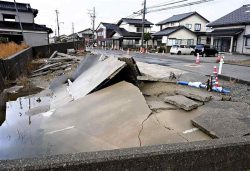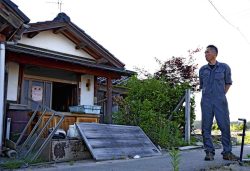Japanese Bar Owner in Disaster-Hit Noto Reunites with His Beloved Dog; More Pet-Friendly Evacuation Centers Needed

Takehito Takaeda and his dog Kenshiro reunite in Suzu, Ishikawa Prefecture on Oct. 15.
13:40 JST, November 26, 2024
SUZU, Ishikawa — A bar owner in Suzu, Ishikawa Prefecture, reunited with his beloved Shiba Inu dog Kenshiro in October, after being separated for nine months as a result of the Jan. 1 Noto Peninsula Earthquake.
Takehito Takaeda, 57, left his dog in the care of a nonprofit organization outside the prefecture because the place he had evacuated to did not accommodate pets. Now, he lives in a temporary housing unit in the city and enjoys living with his dog again.
On Oct. 15, Takaeda watched Kenshiro walking with a staff member of the NPO. He was nervous. What if his dog had forgotten him? But when Kenshiro, who turned five during evacuation, spotted Takaeda, he rushed over to his owner, wagging his tail with excitement. Kenshiro pushed his face against Takaeda’s body and never left his side. “You lost some weight, didn’t you?” Takaeda said with a smile.
In the earthquake and ensuing tsunami, Takaeda’s house, where he also operated a bar, was covered with muddy water, and he evacuated to a nearby welfare facility with his 79-year-old mother and Kenshiro. About two weeks later, they were relocated to a facility that was being used for temporary housing in Uchinada in the same prefecture, about 100 kilometers away from their home. Since the place did not accommodate pets, Takaeda made the painful decision to leave Kenshiro with Peace Winds Japan, a nonprofit organization headquartered in Hiroshima Prefecture that was providing support in the area hit by the disaster.
Kenshiro was put in the care of Yuka Kitabayashi, 43, a company employee in Hamamatsu who helps out with the NPO. The NPO left the dog with her because it considered it better for the dog to receive close care and attention, given his friendly character. Kenshiro got along with Kitabayashi’s own beloved 9-year-old dog, and the two dogs napped and ate together. “I miss Kenshiro. I would like to go to Suzu to see him someday,” Kitabayashi said.
Takaeda is now preparing to reopen his bar before the end of this year. Kenshiro is popular among his regular customers. “Since Ken returned, my life has become cheerful, and I smile a lot more than before. I hope he’ll help breathe life into my bar, too,” Takaeda said as he petted Kenshiro.
Evacuating with pets
People affected by the Great East Japan Earthquake and other past natural disasters were not able to bring their pets to evacuation shelters. This led to the emergence of new social issues, like people taking shelter in their cars and pets wandering around after becoming separated from their owners.
The Environment Ministry in 2013 created guidelines asking pet owners in principle to bring their pets when evacuating. It proposed creating spaces for pets in evacuation shelters and setting up tents where owners could keep their pets. The guidelines were used after the 2016 Kumamoto Earthquake and revised in 2018.
However, according to the Suzu municipal government and others, out of 45 evacuation shelters in the city (as of Jan. 29), only one shelter allows evacuees to keep their pets with them inside the building, although several others allow them to keep pets only in certain spaces on their premises.
The ministry plans to look into conditions at evacuation shelters in the Noto Peninsula Earthquake and other issues, then revise the guidelines again within next fiscal year.
"Society" POPULAR ARTICLE
-

M4.9 Earthquake Hits Tokyo, Neighboring Prefectures
-

M7.5 Earthquake Hits Northern Japan; Tsunami Waves Observed in Hokkaido, Aomori and Iwate Prefectures
-

Tsukiji Market Urges Tourists to Avoid Visiting in Year-End
-

Israeli Tourists Refused Accommodation at Hotel in Japan’s Nagano Pref., Prompting Protest by Israeli Embassy and Probe by Prefecture
-

M5.7 Earthquake Hits Japan’s Kumamoto Pref., Measuring Upper 5 Intensity, No Tsunami Expected
JN ACCESS RANKING
-

Keidanren Chairman Yoshinobu Tsutsui Visits Kashiwazaki-Kariwa Nuclear Power Plant; Inspects New Emergency Safety System
-

Imports of Rare Earths from China Facing Delays, May Be Caused by Deterioration of Japan-China Relations
-

University of Tokyo Professor Discusses Japanese Economic Security in Interview Ahead of Forum
-

Japan Pulls out of Vietnam Nuclear Project, Complicating Hanoi’s Power Plans
-

Govt Aims to Expand NISA Program Lineup, Abolish Age Restriction























